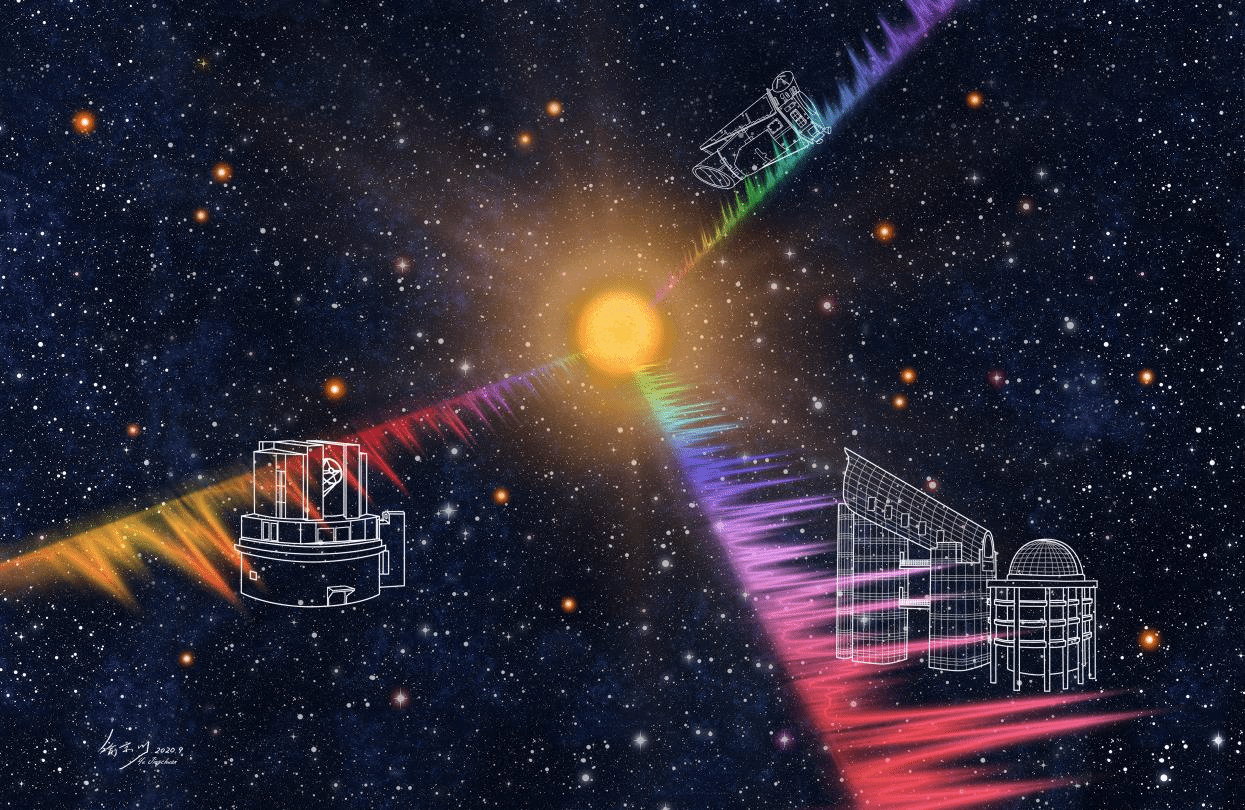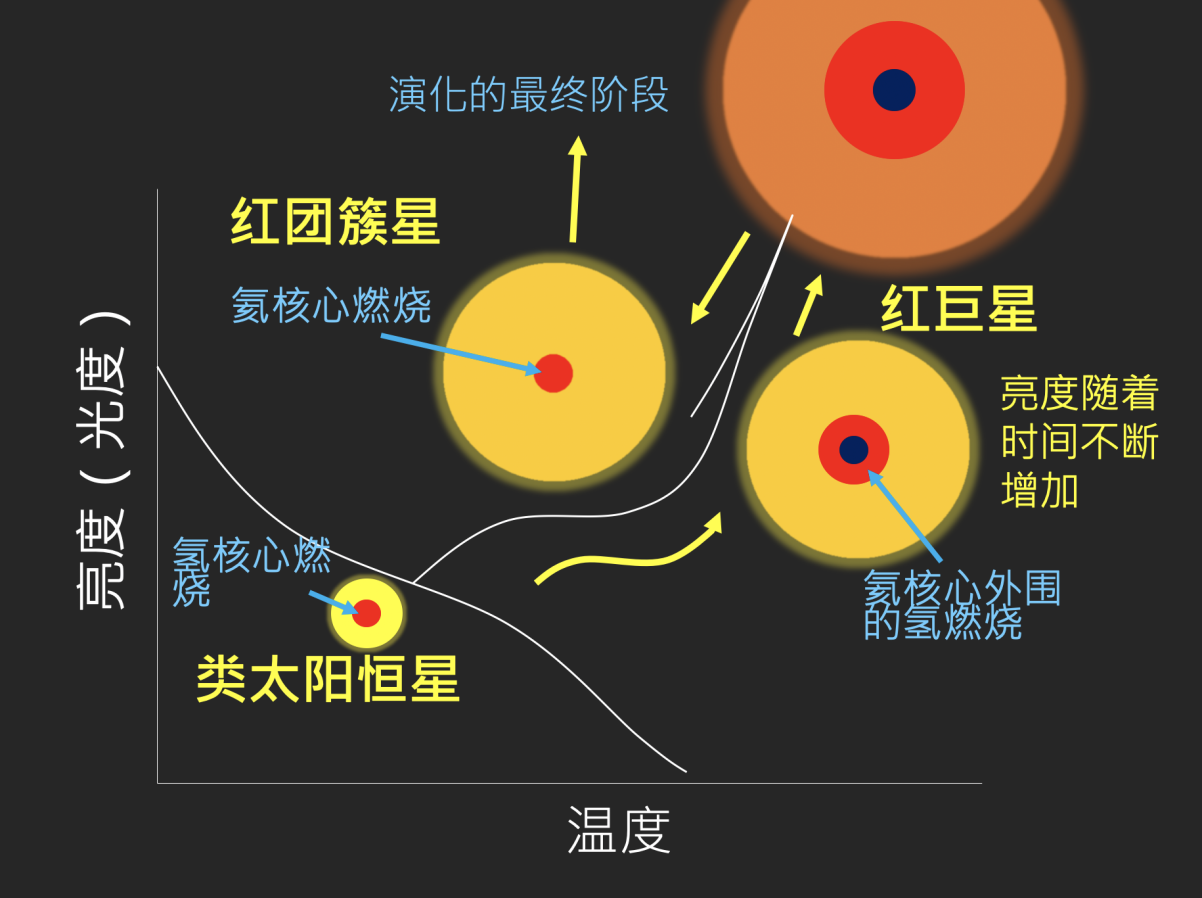锂元素是宇宙大爆炸初期形成的轻元素之一,但它在多种天体中的含量均与理论预测存在较大的差异。锂元素在恒星中的起源与演化问题一直困扰着天文学家,例如,宇宙中有一种被称为富锂巨星的天体,它们锂元素的含量超过恒星演化理论值的上千倍,这些的天体中的锂是如何产生的?天文学家一直在努力寻找答案。

图1. 天文学家通过星震并分析恒星的光谱揭秘富锂巨星的真实身份
(图源:国家天文台供图, 版权:喻京川,北京天文馆)
2020年10月6日,《自然·天文》(Nature Astronomy)发表了一项由我国天文学家主导的国际科研团队关于富锂巨星真实身份的重要成果,北大天文系LAMOST Fellow博士后周渝涛作为共同第一作者参与了该研究工作。该团队借助我国大科学装置郭守敬望远镜LAMOST,以及开普勒太空望远镜的星震数据,结合光谱分析和星震学技术,发现富锂巨星其实是演化到更晚期的红团簇星,而不是传统上所认为的红巨星。这一发现使恒星演化方面原有的相关理论受到了巨大地挑战,对解开锂元素的起源之谜至关重要。

图2. 小质量类太阳恒星演化示意图。黄色箭头标记了恒星演化的轨迹。红巨星的初期与红团簇星大小相似,颜色相同。
(图源:国家天文台供图, 版权:Wako Aoki青木和光,日本国立天文台)
恒星如同人类一样,会诞生、成长、衰老、死亡。太阳就是一颗正处于青壮年时期的恒星。不过,随着恒星不断发光发热,其内部物质会出现明显的变化,并由此产生一系列改变。红巨星和红团簇星是恒星进入晚年后两种不同阶段,它们内部进行核反应的物质完全不同,因此其结构和物理过程也具有显著差异。但是,仅从恒星的表面特征或者赫罗图上看,很难判断恒星确切的演化阶段。就如同我们很难辨认两位白发苍苍的老人谁更难老一样。此前的研究认为,随着恒星朝红巨星演化,恒星内部的对流速度逐渐增大,红巨星快速对流的环境十分有利于生成富锂现象。但是,经过几百万年后,红巨星将演化成“样貌相似”的红团簇星,因此,红巨星有理由被错认为年纪更大的红团簇星。
科研团队通过我国的LAMOST、日本昴星团等国内外多架望远镜采集了大量富锂巨星的光谱,并借助开普勒卫星对这些富锂巨星的振动进行了监测,得到了截然不同的结论。恒星内部结构的信息通过振动的方式传播至表面并被观测到,尽管红巨星和红团簇星在光度和温度等特征上看起来十分相似,但两者的内部振动模式并不相同。假如我们把恒星的振动比作人类的心跳,那么红巨星的心率会快一些,而更年老的红团簇星则心率更慢一些。研究发现,超过80%的富锂巨星是红团簇星,而且不同类型的富锂巨星在锂含量、恒星质量等多个方面均与传统认知存在显著不同。
这些发现很难用传统理论去解释,由于内部物理环境不同,原有的理论并不适用于红团簇星。不少新的理论试图用于解决这一问题,包括氦闪、双星并合、特殊的对流等等。对此,该论文通过观测数据检验了双星并合产生富锂巨星的理论,认为这是一种有潜力的方向。虽然目前尚无定论,但下一步的关键就是去逐一检验这些理论,找到真正的原因。
据悉,该工作是由一个中国主导,包括来自日本、法国、荷兰、美国以及澳大利亚等多国科研人员的国际团队所合作完成的。中国科学院国家天文台、北京大学、北京师范大学和云南天文台等国内单位均参与其中。在此研究中,多个望远镜的协同合作是取的成果的关键,除LAMOST和开普勒卫星外,日本的昴星团望远镜、我国云南天文台的2.4米和1.8米望远镜均在观测中发挥了重要作用。
文章链接:https://www.nature.com/articles/s41550-020-01217-8
Lithium is one of the light elements produced at the early universe. As one of the building blocks of our present-day universe though, the context of lithium observed in many celestial bodies often disaccord with predictions of classic theories. Lithium-rich stars, accounting for only 1% of the total number of the low-mass evolved stars, is one example of such conflict. They preserve up to thousands of times more lithium than the normal stars that account for the rest 99%. Astronomers are wondering what these stars really are and why.
A recent study revealed the real status of lithium-rich stars by the Chinese astronomers is published in the Nature Astronomy on Oct.5. Yutao Zhou, the postdoc from the department of astronomy, is involved in this study as the co-first author. By combining the LAMOST with the Kepler, they find that most lithium-rich stars locate at the evolutionary status of red clump instead of the red giant branch as previously thought. The findings challenge the corresponding stellar theories, which is vital to resolve the problem of lithium origin.
The red giant and the red clump are the different statuses after the main sequence, their internal structure and physical process are significantly different because of the distinctive nuclear reactions in the their interiors. However, it is really hard to tell which status the star is by the external characteristic or the H-R diagram.
Previous observations suggested that the lithium is produced in the star at the red giant branch, many researches focused on the extra-mixing processes of the red giant star, trying to settle the issue of lithium enhancement. The skeptical research team obtained a quite distinct result with the help of the asteroseismic information from Kepler and the stellar spectra from LAMOST, Subaru, etc. Because of the different internal oscillation modes, the red giant star and the red clump star can be distinguished by the asteroseismology, though they look alike on the features of luminosity and effective temperature. The research shows that over 80% of lithium-rich stars are the red clump star. Moreover, the lithium-rich stars at these two statuses present different distributions in the lithium abundance, the stellar mass, nitrogen abundance, etc, which contradict the previous studies.
All of these signatures are hard to explain using the current scenarios. The lithium-rich scenarios of red giant star should not be appropriated for the red clump star due to the different internal structures. A few theories were proposed to account for this issue, including helium flash, binary-merger, extra-mixing, etc. The research finds that the binary-merger is a potential scenario by verifying its predictions with the observational results. To check the other theories is a further step to the truth of lithium-rich secret.
The research is done by an international team with scientists from institutes worldwide, including China, Japan, France, Netherlands, United States, Australia, and Denmark. The involved Chinese institutes include National Astronomical Observatories of CAS, Peking University, Beijing Normal University and Yunnan Observatories. Besides LAMOST, Subaru, and Kepler, four other telescopes contributed the data, including the 3.5-meter telescope at Apache Point Observatory, the Automated Planet Finder telescope at Lick Observatory, the 2.4-meter and 1.8-meter telescope at Lijiang Observatory.
Publication link: https://www.nature.com/articles/s41550-020-01217-8
